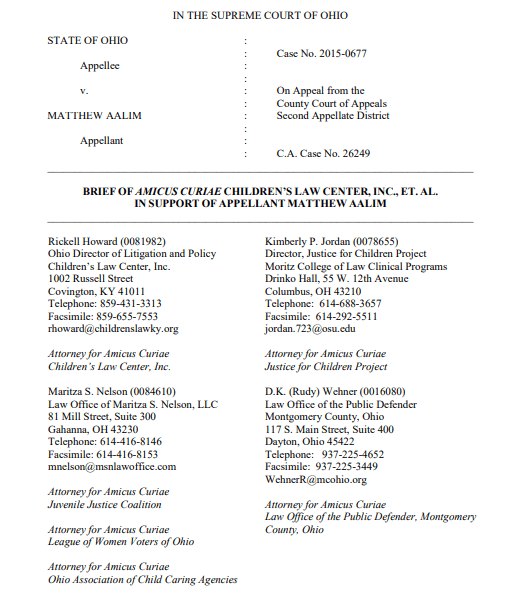
Summary of Argument
Being incarcerated as a juvenile in a juvenile facility wasn’t great. But being bound over as a juvenile in an adult prison is torment. I wouldn’t want any juvenile to ever experience the pain and suffering I experienced. * * * I was left with no choice but to fend for myself and fight for my belongings at a young age. – D.N.
The hardest thing for me has been watching [my nephew] take blow after blow in his life and still not get any grace or mercy or compassion or empathy from the system. None of what he’s been through is even considered. – L.S.
“Since its origin, the juvenile justice system has emphasized individual assessment, the best interest of the child, treatment, and rehabilitation, with a goal of reintegrating juveniles back into society.” State v. Hanning, 89 Ohio St.3d 86, 88-89, 728 N.E.2d 1059 (2000). These unique characteristics of the juvenile court reflect the firmly established notion that youth are different than adults and the importance of making individualized decisions for youth – even youth who commit serious offenses and who are deeply involved in the adult criminal justice system. See e.g., Roper v. Simmons, 543 U.S. 551, 551, 125 S.Ct. 1183, 161 L.Ed.2d 1 (2005) (prohibiting the death penalty for individuals under the age of 18); Graham v. Florida, 560 U.S. 48, 48, 130 S.Ct. 2011, 176 L.Ed.2d 825 (2010) (prohibiting youth from receiving life without the possibility of parole for non-homicide offenses); Miller v. Alabama, __ U.S. __, 132 S.Ct. 2455, 2457-2459, 183 L.Ed.2d 407 (2012) (finding mandatory life without parole sentences unconstitutional for youth under age 18 without consideration of the youth’s age and family and home environment, the circumstances of the offense, and potential for rehabilitation); In re C.P., 131 Ohio St.3d 513, 2012-Ohio-1446, 967 N.E.2d 729, ¶ 38-62 (finding that mandatory lifetime sex offender registration does not allow courts to take into account the relative culpability of youth and ability to be rehabilitated, the nature of the offense, and the relative severity of the punishment, including the increased proportion of the youth’s life that a sentence would affect).
Ohio’s mandatory bindover law should be eliminated based on constitutional challenges as outlined in Matthew’s merit brief. This amicus brief provides additional evidence supporting these constitutional challenges, including further support, by juvenile justice system stakeholders, youth-focused organizations, and the public, of a national and Ohio consensus against the mandatory transfer of youth to adult court.
Mandatory bindover does not comport with the widely accepted constitutional premise, based in case law and research, that the hallmark features of youth require an individualized analysis when determining whether a youth should be transferred to adult court. However, despite efforts over the years to limit the use of mandatory bindover in Ohio by creating less harsh alternatives, including the passage of Ohio’s Serious Youthful Offender laws in 2000 and reverse waiver laws in 2011, mandatory bindover continues to be used at a relatively high rate and these alternatives have been underutilized—resulting in hundreds of youth being transferred to adult court without an individualized decision-making process. Finally, Ohio’s mandatory bindover law is not meeting its intended goals and goes against the fundamental purpose of Ohio’s juvenile code.
To be clear, in mandatory bindover cases – such as the case at bar – juvenile court judges only have authority to determine whether probable cause exists that the youth committed the offense. R.C. 2152.12(A)(1)(a)(i). This analysis does not require any examination of the specific circumstances of the particular case, including the youth’s individual characteristics or role in the offense. Instead, it is a minimal “yes or no” determination, which leaves the essential question of whether to bindover a youth in the hands of the prosecutor, a party to the proceedings, rather than a juvenile court judge. Therefore, in mandatory bindover cases, discretion rests with the prosecutor, who is not guided by a set of factors to consider and whose decisions are not subject to appellate review. U.S. Dep’t of Justice, Office of Juvenile Justice & Delinquency Prevention, Trying Juveniles as Adults: An Analysis of State Transfer Laws and Reporting (2011) 2, available at https://www.ncjrs.gov/pdffiles1/ojjdp/232434.pdf (accessed January 4, 2016).